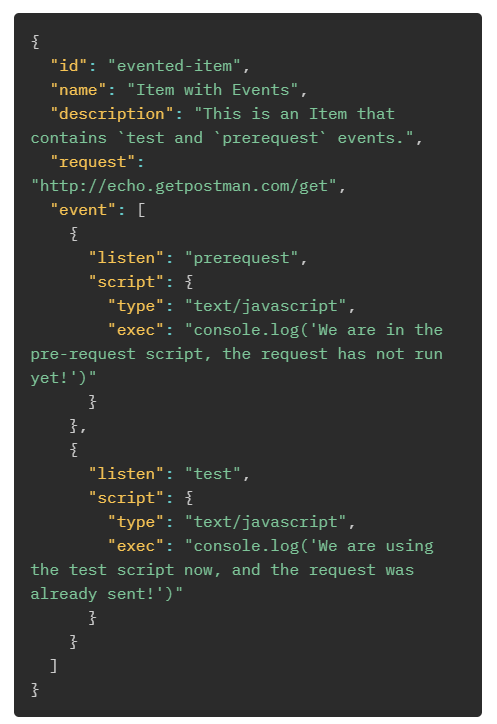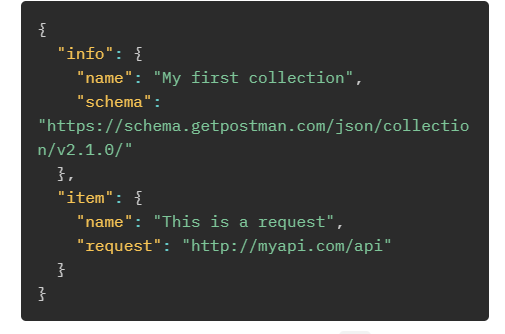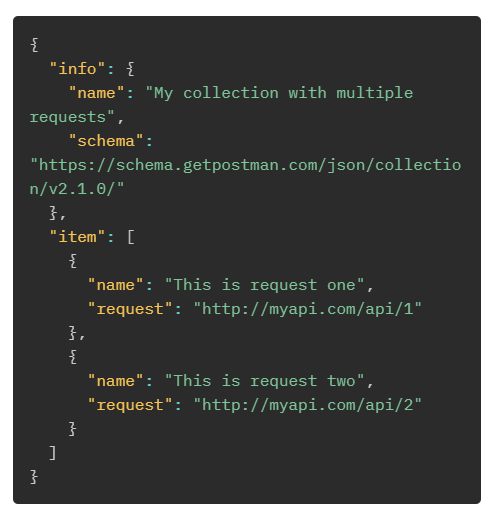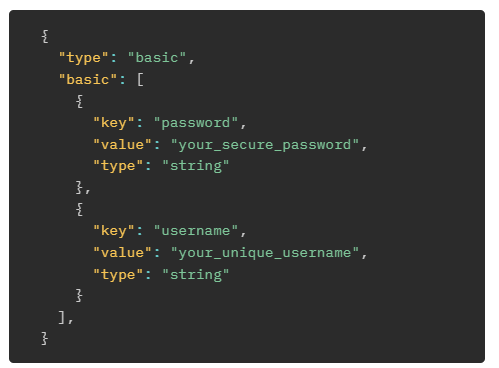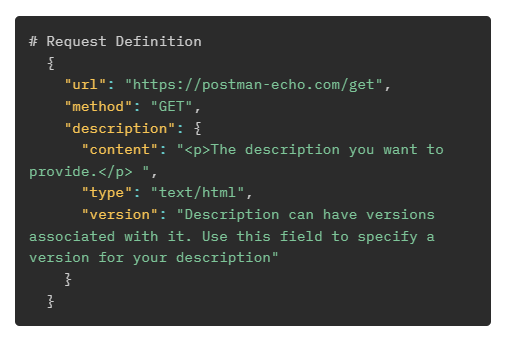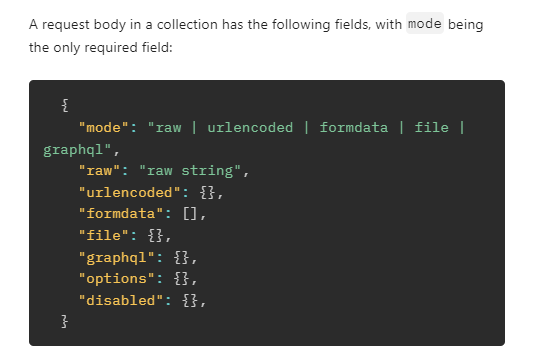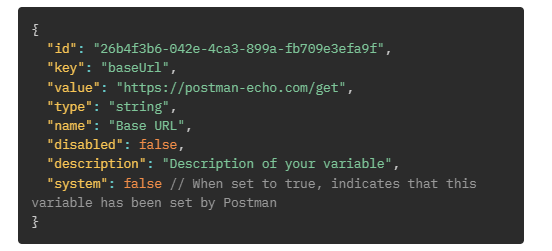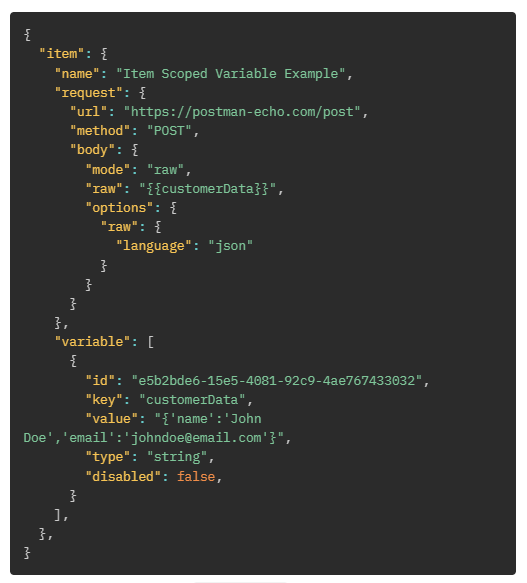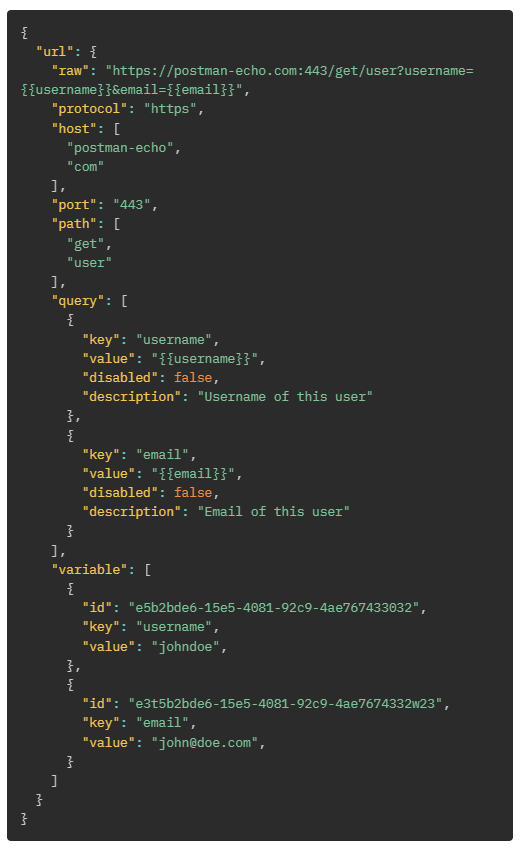Diving-Deep: Postman’s Open-Source Collections Format (Postman 3 of 4)
Explore Postman's open-source collections for seamless API collaboration
Introduction
The Postman Collection Format is a standardized specification and format to create, use and share API environments. It was developed by Postman, the most popular API development and testing tool, but a Collection Format is an open-source, open specification in JSON format.
Postman Collection Format
Structure of a Collection
There are five keys that define a collection object
$ info
Contains metadata about the collection such as name, description, schema version, and more
$ item
Represents individual requests or folders
Each request can have various details like method (GET, POST, etc.), URL, headers, body, etc
$ event
Allows for scripting and automation of requests using pre-request and test scripts
$ variable
Variables that can be used across the collection for dynamic data
$ auth
Authentication details for API requests
Open Source vs. Postman Proprietary
Open Source Components
Postman Collection Format
The format itself is open source and its specification is publicly (open license)
This means anyone can create, read, and manipulate collections outside of Postman
Postman SDK
A Node library for working with Postman collections programmatically
It allows for creating, reading, updating, and transforming collections using JavaScript
Newman
Newman is a CLI tool to run Postman collections
This is an open source project and widely used for CI/CD and automated testing
Proprietary Postman Components
Postman App
The Postman App (Desktop, Web) is the first and main proprietary part of Postman
The app itself is proprietary software, though it's available for free
Postman Pro and Enterprise
Paid plans that offer additional features such as enhanced collaboration, monitoring, and API documentation hosting
Postman Cloud Services
Postman also offers other cloud-based services that accompany the main product
Features include … cloud-based workspaces, API monitoring, and version control for collections are part of Postman's proprietary offerings
This tutorial will cover Postman Collection’s architecture, key concepts, and practical use cases to give you ideas on how to use it.
Contents
Architecture Overview
Concepts
Reference
Architecture Overview
A Collection is an API specification
It provides a format for representing, modeling and organizing different parts of an API request or workflow
Features
Share and execute API requests
Define different aspects of your API
Models workflows
Work across the lifecycle of your API
Document and test
Example Collections
The Collection Format is open source
The basis of Collections in Postman
Advantages
Human readable and machine interpretable (JSON)
Interoperable (OpenAPI, GraphQL)
Portable
Code and documentation generation
Structure of a Collection
Info
Item
ItemGroup
Request
Events
Consists of a set of reusable parts, known as units
Units can be nested within each other and used in different parts
Info
A collection has a single info block
$ info contains metadata about the collection
Collection name
Schema
Version
Description of the collection
Item
The Item is the basic building block for a collection
Represents an HTTP request, along with the associated metadata
$ item is an object or array
Contains
An API request
An API response
Related metadata
ItemGroup
A container for items (like a folder)
Properties
$ id
$ name
$ description
A collection is an item group with an additional and special info block
Request
Represents an HTTP request
A request can be found within an item or item-group → item
A request can be specified as a string or JSON object
If string, it is assumed to be GET request
Events
Events let you declare scripts (pre-scripts) to run at certain stages in the lifecycle of a request/collection
Written in Javascript
Run using the Postman Sandbox
Event Types
There are two types
Test Script
Associate a test script with an item
Executed after the actual HTTP request is sent and the response is received
Pre-Request Script
Executed before the HTTP request is sent
Postman Sandbox
https://github.com/postmanlabs/postman-sandbox
A Sandbox for Postman Scripts to run in Node or the browser
You can trigger requests and listen back for events
Defining an API
https://learning.postman.com/collection-format/getting-started/defining-a-simple-api
Contents
API Structure
APIs with Multiple Requests
Nesting Folders
API Structure
A collection has two mandatory units
$ info
$ item
The minimal API implementation
The request above is a URL and defaults to GET
APIs with Multiple Requests
To define multiple requests, item becomes an array of item objects
Nesting Folders
Item groups (folders) can be nested inside folders
These allow you to organize APIs based on different types of objects or blocks based on your requirements
Concepts
Contents
Structure of a Request
Structure of a Response
Variables
Events
Documentation
Extending Collections
Differences Between the Collection Format and Postman Collections
Structure of a Request
Collections let you organize API requests
An API sits between an application and a server
An app can use an API to communicate with a server and perform actions with the use of a database
Contents
Request object
Request headers
Request methods
Authorization
Auth attributes
Description
Request body
mode
raw
urlencoded
formdata
file
graphql
URLs
Configuring proxies
Certificates
Request Object
When a request is a string, it is a simple GET request
If it is not a string, it is a more sophisticated request - an object
Example
URL - The request URL
Auth - Reference Object
The authentication helpers
Method - HTTP Method (GET | POST | PUT | PATCH | DELETE)
Description - Raw text or an object that holds the description along with its format
Header - An HTTP header
Body - The data contained in the request body
Certificate - SSL certificate
Proxy - Configure a custom proxy in Postman for a particular URL match
Request Headers
This can be an object or array of objects
Each is object is represented by a KV pair object
Properties
Key - The key of a specified header attribute
Value - The corresponding value
Disable - Boolean - Indicates if the header is included or not in a request
Description - A nickname that describes the header attribute
Request Methods
Supported HTTP methods
$ GET | PUT | POST | PATCH | DELETE | COPY | HEAD | OPTIONS | LINK | UNLINK | PURGE | LOCK | UNLOCK | PROPFIND | VIEW
Authorization
These help to validate the client side identity using a client-provided credential
Data is transferred in plain text or in an encrypted form to a server
The server then validates the authorization credentials
You can specify these types of authorization headers in request definitions
$ apikey | awsv4 | basic | bearer | digest | edgegrid | hawk | noauth | oauth1 | oauth2 | ntlm
Authorization is represented using the auth attribute
It requires a ‘type’ KV with any of the types above
Next, you specify the authorization values in a basic object or array
Auth Attributes
An auth attribute is a JSON KV object
Represents the credentials contained in an authorization
The authorization of type basic has a basic property
An auth attribute refers to the basic property, with its list of objects
This is an example of a full request object
This object contains an auth object and an auth attribute of ‘bearer’
Description
Add more context to your definitions
They can be string | objects
Objects can contain Markdown, HTML or plain text
Request Body
Collections support five request body types
$ raw | urlencoded | formdata | file | graphql
Properties
The mode is the type field
Then, you use the type name as a key to specify the object
Raw
A string or serialized version of the request payload
The serialized data can be JSON | XML | HTML | plain text
URL Encoded
URL-encoded data in KV pairs
You can also add the disabled property and a description
Form Data
Similar to how URL Encoded is defined
Define text, files or any type of data to submit over an encoded multipart/formdata
If your data is a file that uses an absolute or relative path, use src instead of value
GraphQL
GraphQL requests are made over HTTP in the same way as GET | POST | …
Collections should be provided in the request body, specifying the schema and variables
Proxies
If you have a proxy set up, you can provide configuration for a proxy
The proxy request helps you do this with the following properties
$ match - The URL match for the proxy config
$ host - The server host
$ port - The server port
$ tunnel - The tunneling details for the config
$ disabled - Whether it is enabled or not, allowing you to define it without having it always on
Certificates
Specify one or more SSL certificates using the certificate property
Each certificate has the following
$ name - A name for reference
$ matches - An array of URL match pattern strings to identify URLs this certificate can be used for
$ key - An object containing path to file containing the private key on your local file system
$ cert - An object containing the path to the file certificate on your local file system
Structure of a Response
https://learning.postman.com/collection-format/advanced-concepts/response-definition
For every request made over HTTP(S), there is an HTTP(S) response
There is a response object in Postman, under a collection
This allows you to represent and utilize response objects
Contents
Original Request
Headers
Body
Response Object
Lets you define different parts of an HTTP response
Includes
Status
Response headers
Response body
Original request
Variables
https://learning.postman.com/collection-format/advanced-concepts/variables
Variables in collections let you declare a value once and reuse it later
You can use them in multiple places
Contents
Definition and Usage
Collection Variables
Unit Variables
Use Cases
Definition and Usage
A variable is defined using a variable list
A variable list is an array of variable objects
Each variable object has a KV pair and some metadata
An example of a variable type
To use a variable, place double (two) curly braces wherever you need them
Variables can use in the following locations
URLs
Request headers
Request bodies
Example: {{variable-key}}
Variables can also be scoped on a global | collection | request level
Collection Variables
Collection variables are declared in the upper scope of the collection object
These can be used anywhere within a collection
An example of a Collection declaration with a variable
Unit Variables
Collections consist of substructural parts known as units
Units can be nested within another unit
A variable is an example of a collection unit that can be nested in other units
When a variable is nested in another unit, it is called a unit variable
Unit variables are scoped to the unit in which they were declared - and don’t exist outside it
Collections come with two unit variable scopes: item and URL
Item
Item-scoped variables are scoped to the item unit of a collection
Recall that an item refers to a request-response pair
This defines the use location of a variable
In this example, you see that the variable customerData is defined inside the item scope
This is being used in the body of a request
The variable is scoped to this item and cannot be called by other items
URL
Variables can also be scoped to a URL
This means that they can only be called or used from within that URL object
Use Cases
Variables in query params
Variables in a request body
Variables in GraphQL
Variables in query params
Variables in a request body
Variables in GraphQL
Events
https://learning.postman.com/collection-format/advanced-concepts/events/
Events let you declare scripts that you can execute at certain stages of the lifecycle of a request or collection
Scripts are written in Javascript
Scripts can be executed using the Postman Sandbox
Pre-request Scripts in Postman | The Exploratory
Inside a Collection > Pre-request script
This runs before every request in a collection
For an individual request, you have exactly the same menu inside an individual request
Pre-requests have access to the Postman objects and you can do any of the following, among other things
Get an environment | collection | global variable
Set an environment | collection | global variable
Log messages to the console
Run general operation / execution scripts written in Javascript
Scripts
Pre-Requests - Runs before requests execute
Tests - Runs after requests execute
Contents
Event Object
Scripts
Pre-Request Scripts
Test Scripts
Event Object
An event object is defined using an event-list, which is an array of event objects
Scripts
Scripts listen to events and fire when they occur
The script object defines the code that runs
Properties
$ id
A unique, user-defined ID
Refers to this unique script
$ name - The nickname / name of a script
$ type = text/javascript
$ src - A reference / path for external scripts
$ exec - An array of strings, each representing a Javascript line, in sequential order
Scripts allow you to model workflows for requests
Pre-Request Scripts
These listen to the prerequest event type
Execute right before a request is made
These allow you to modify headers, parameters, variables and more
These are also useful for data pre-processing and logging
Test Scripts
These listen to the test event type
Execute right after you receive a response from a request
You can utilize the response data, transform it and use it for other purposes
You can also run assertions against the response
Documentation
https://learning.postman.com/collection-format/advanced-concepts/documentation
Documenting Collections
Collections have different units that each describe a specific block
is it is recommended that you use the description object for each of these sections to document your API
Description Object
All descriptions, on every entity object, can be specified as plain text | Markdown | HTML or any MIME type
Entities with a description Object
Collection
Folder (ItemGroup)
Request
Response
Variable
API Schema
Extending Collections
https://learning.postman.com/collection-format/advanced-concepts/extending-collections
Collections are multiple sub-structural parts, known as units
Each unit defines a part of your API
Extensions allow you to extend these parts
Provide more metadata
Add more fields or data
You can place them on any collection
Designated with a prefix “_” underscore before the field names
They can contain any data type … strings, objects, integers, etc
Collection Format vs Postman Collections
When you export a Collection in Postman, you are exporting a JSON object in the open-spec format
This is the JSON Collection format that defines your API
It includes all of your
Headers
Request bodies
URLs
Variables
… and more
There are some differences between Postman collections and the Collection format
Postman provides extra functionality abstracted over the format to improve experience
In an export, certain Postman-specific items will not be included in the exported JSON
Contents
Auto-Generated Request Headers
Schema Referencing
Variables and Environments
Cookies
Scripting
protocolProfileBehavior
Proxies
Auto-Generated Request Headers
Headers is available on a collection or request
You can include multiple headers in a single request
Postman assigns default headers on collections and requests
When you export in Postman, default headers (set by Postman) are not included
The Postmans info icon indicates that they’re recommended headers
Variables and Environments
Variable Scrops
Global variables
Available across an entire workspace
You can use them in any collection within that workspace
When you export a collection that uses a global variable in Postman, the reference to that variable is included, but the declaration of the variable isn't included in the export because it isn't part of that collection
Collection variables
Declared within the collection scope of your workbench in Postman
Directly translate to collection variables in the Collection format
Always included in the exported JSON
Environment variables
Enable you to scope your work to different environments
For example, development, testing, or production
One environment can be active at a time
The active environment determines what variables you can use within your collection
If you're using a collection variable, this variable isn't included in the variable declaration of your exported collection JSON - however, there are places in the exported collection that reference where this variable was being used
Cookies
Cookies are not part of the request object in the Collection format
When working with cookies inside Postman, you can add them to the headers using the cookie key
Scripting
Capabilities of scripting
External referencing
Scripts written in Postman are typed and authored in the script or pre-request tab
When exported, they're placed in the exec field of a script object as an array of strings
The Collection format provides you with an extra option for referencing external scripts using src
Scripts as arrays
When you export a collection that has a pre-request or test script in Postman, the JavaScript code is split into an array at each line break
This makes it easier to manage version control on the exported script
Multiple scripts
In Postman, a collection or a request can only have one pre-request and test script pair
While they look like a pair, in the Collection format, they aren't a pair
They are instead separate events in an event list
The event list can have more than two events
Postman specifically limits usage to two events per collection or request - however, the event list can accommodate more pre-request and test scripts
protocolProfileBehavior
When you export a collection from Postman, you might see protocolProfileBehavior
The schema doesn’t say much about this property, but it’s used as a set of configurations to change the usual behavior of a sent request
Protocol Profile Behavior
https://github.com/postmanlabs/postman-runtime/blob/develop/docs/protocol-profile-behavior.md
These are configs that alter the usual behavior of sending requests
Reference
https://learning.postman.com/collection-format/reference/collection
The full API Reference specification for Postman Collection Format
This includes all the keys and properties for all the individual objects
Objects
Collection
Authorization
Auth Attribute
Certificate
Certificate List
Cookie
Cookie List
Description
Event
Event List
Header
Header List
Info
Item
Item Group
Request
Response
Script
URL
Variable
Variable List
Version
Proxy
Protocol Profile Behavior









